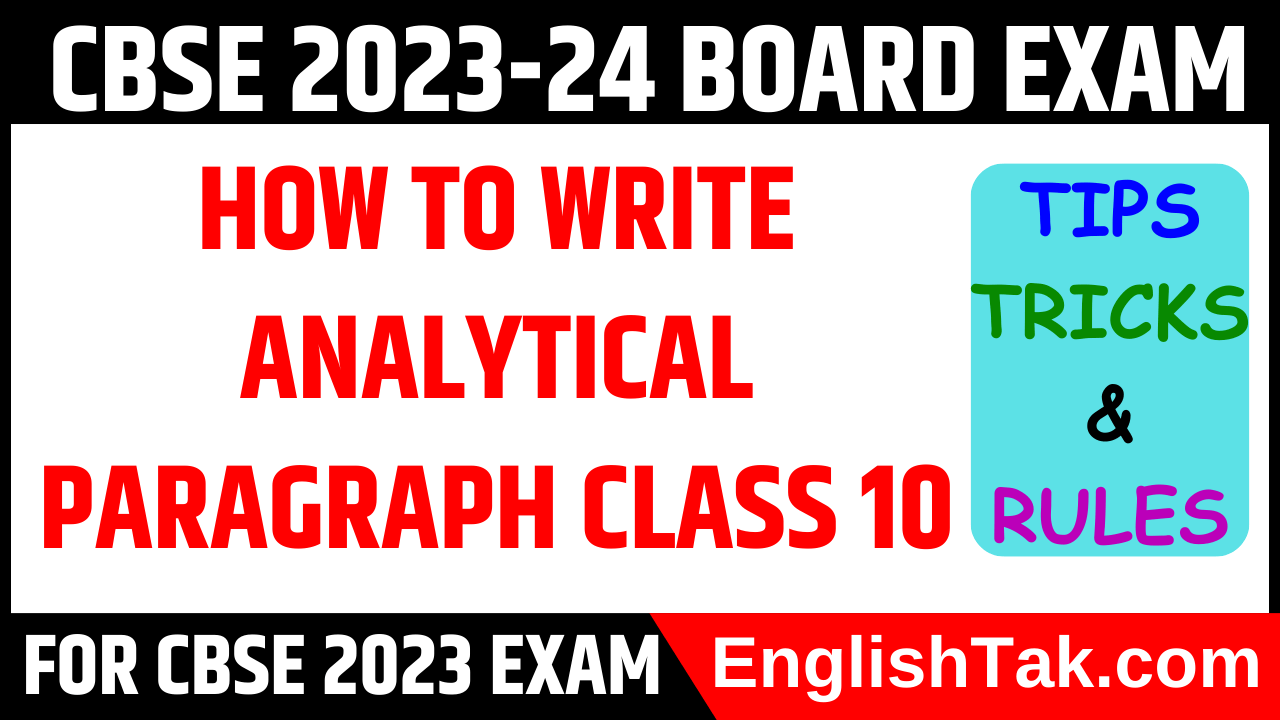![]()
How to Write Analytical Paragraph Class 10
Table of Contents
How to Write Analytical Paragraph Class 10 – A type of descriptive writing which is written on the basis of given chart, graph, data, clues, etc. is called analytical paragraph. This form of writing requires analysis and comparison of the given facts and figures and drawing conclusion based on the given data. It is used to derive information from a collected set of data. This data can be in the form of bar graph, table, line graph or pie chart, etc. The data can also be given in the form of clues or data outlines. This form of writing is used to interpret the facts presented in the given source. A graph or chart is a visual stimulus to depict the data.
The purpose of analysis is basically to examine the whole part as a basis for clarification, interpretation and discussion. The student is required to provide an analysis and comparison of the given facts and draw conclusions based on the given data. Compile the given set of data and frame it into a paragraph. However, remember not to include any additional information which has not been mentioned in the given graph or clue.
How to Write Analytical Paragraph Class 10 – Formation
Beginning: Always begin your writing by giving an introduction of the given information. Describe the topic of analytical paragraph writing in 2-3 lines. Body of the Analytical paragraph : In the body of the analytical paragraph, divide the given information in two paragraphs. State the facts given in the graph or chart. Draw comparisons if required and write the information using a crisp language. Never deviate from the topic and don’t add any information not provided in the chart or graph.
Conclusion : This is the concluding part of Analytical paragraph writing, sum up the information in last paragraph in a very precise form.
Important Points for Analytical Paragraph:
« Understand the objective of the given graph or chart
« Use given evidence to make your point
« Write the introduction, body paragraphs and conclusion
« Don’t include facts that can’t be supported with a reference
« Focus on the quality and not the quantity
« Keep it clear, concise and unambiguous
How to Write Analytical Paragraph Class 10
Points to remember in Detail:
1. Understand the Prompt or Topic:
– Read the prompt or topic carefully.
– Identify key terms and concepts.
– Make sure you understand what is expected in your analysis.
2. Read the Text Thoroughly:
– If it’s a literary passage, story, or poem, read it carefully.
– For other subjects, understand the data, graphs, or information provided.
3. Identify the Main Idea:
– Determine the central theme or main idea of the text.
– Understand the purpose and message conveyed by the author.
4. Highlight Key Points:
– Identify important details, examples, or evidence that support the main idea.
– Highlight literary devices, if analyzing a literary text.
5. Organize Your Thoughts:
– Create a rough outline of your paragraph.
– Decide on the order of presenting your points logically.
6. Introduction:
– Start with a strong opening sentence that introduces the main idea or theme.
– Mention the author or context if applicable.
– Provide a brief overview of what your analysis will cover.
7. Thesis Statement:
– Include a concise thesis statement that clearly states your main argument or interpretation.
8. Body Paragraph:
– Start each paragraph with a topic sentence that relates to your thesis.
– Provide evidence, examples, or quotes from the text to support your analysis.
– Explain how the evidence supports your interpretation.
– Use transition words to connect ideas and maintain coherence.
9. Analysis:
– Analyze the significance of the evidence you’ve presented.
– Discuss the author’s intentions, techniques, or the impact of the information.
10. Conclusion:
– Summarize your main points.
– Restate your thesis in a different way.
– Conclude with a thought-provoking or insightful statement.
11. Check for Clarity and Coherence:
– Ensure that your paragraph flows logically.
– Check for grammatical errors and clarity of expression.
12. Review and Revise:
– Take a break and then review your paragraph.
– Make necessary revisions for clarity, coherence, and overall effectiveness.
13. Word Count and Time Management:
– Keep an eye on the word count, if specified.
– Manage your time wisely during exams; allocate enough time for planning, writing, and revising.
14. Practice:
– Practice writing analytical paragraphs regularly to improve your skills.
Remember, practice is key to mastering the art of writing analytical paragraphs. The more you practice, the more confident and proficient you will become.
English For Class 10th Board
Complaint Letter Class 10 Solved Exercise
Editing Exercises for Class 10 CBSE 2023 Board
Unseen Passage for Class 10 with Answer
Top 10 Long Questions Answers for 10 Board 2023-24
Glimpses of India Class 10 MCQ Questions
From Diary of Anne Frank MCQ CBSE Class 10 English





